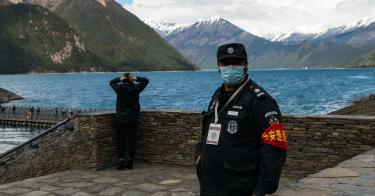China and India were at it again this month. According to Indian news reports, border patrols from both countries have been involved in a series of incidents along their disputed boundary in recent weeks, including a pair of confrontations in early May that devolved into fisticuffs.
On May 5, the two sides came to blows on the banks of Pangong Lake, where Ladakh meets Tibet, and where the two sides have registered multiple confrontations in recent years. On May 9, dozens of soldiers from both sides tussled along the Sikkim-Tibet border, resulting in injuries on both sides. In both cases, tensions were quickly defused, forces disengaged, and local commanders opened lines of communication. Nevertheless, the incidents draw attention to, and raise questions about, the apparent uptick in volatility along the disputed boundary.
The 2,167-mile China-India border, by some estimates the longest disputed border in the world, has witnessed ongoing friction since a short but intense war in 1962. The Line of Actual Control (LAC), as the perceived boundary is known, is far calmer than the one separating Pakistan and India in Kashmir, where deadly artillery shelling and kidnappings occur regularly. Yet the mostly desolate and mountainous LAC is the site of frequent “transgressions” by Chinese border patrols, regular face-to-face meetings between patrolling units from both sides, and occasionally violent or prolonged confrontations.
The volatility results partly from disagreement over the precise location of the LAC along a dozen or so contentious stretches of the border, including Pangong Lake. The Indian government registered 273 Chinese border transgressions in 2016, 426 in 2017, and 326 in 2018. After the decline in 2018, some reports suggest the number of Chinese transgressions surged by 50 percent in 2019. China does not report publicly on Indian transgressions.
In the vast majority of cases where Chinese and Indian border patrols do meet face-to-face, they engage in a flag ceremony and disengage peacefully. But not always.
Several prolonged standoffs in recent years have attracted media attention and been elevated to the political level. In 2013, Chinese forces objected to the construction of an Indian observation post near the LAC in the Depsang Valley in northern Ladakh. A 21-day standoff ensued. The following year saw a 16-day standoff in southern Ladakh near Chumar after China tried to stop the construction of a water irrigation channel near the LAC. The latter face-off coincided with, and helped to undermine, President Xi Jinping’s inaugural visit to India in September 2014.
The most notorious of the recent face-offs occurred in the summer of 2017 on the Doklam plateau. At the time, Indian forces intervened to stop a Chinese military construction crew from extending a road into disputed territory in Bhutan that could have given Chinese forces an advantaged position over one of India’s more strategically vulnerable geographic regions. The 73-day standoff was the longest and most volatile in recent history, with Beijing issuing unusually direct and escalatory threats to India: unilaterally withdraw or be evicted by force.
Indian forces stood their ground until the two sides reached a mutual withdrawal agreement, although China has continued to develop infrastructure in adjacent areas. The Doklam crisis helped prompt a summit between Prime Minister Narendra Modi and President Xi in Wuhan in 2018 that mostly succeeded in putting bilateral ties on a more stable footing.
Other incidents along the LAC have been less strategic in nature. Occasionally, a stare-down between Chinese and Indian patrols devolves into fist-fighting, though public reports of such confrontations were rare before 2017. A video of an incident near Pangong Lake that August famously captured a scuffle and lively exchange of rock-throwing between Chinese and Indian forces as the Doklam crisis was unfolding hundreds of miles to the east. In 2019 there were public reports of another confrontation at Pangong Lake, which is bisected by the LAC: China controls the eastern two-thirds of the lake, India the western third.
The May 5 incident erupted along a volatile stretch of the lake where Chinese and Indian perceptions of the LAC diverge and overlap. Indian media reports indicate tension “had been building up over time after aggressive patrolling by the Chinese side,” and after both countries sent additional troops to reinforce the area following a confrontation last year. While the two sides quickly separated, reporting suggests additional troops have been moved to reserve positions.
On May 9, Chinese and Indian forces reportedly engaged in a separate clash where the Indian state of Sikkim meets Tibet. Four Indian and seven Chinese soldiers suffered injuries in a scuffle that involved roughly 150 soldiers in total. The Indian press has carried reports of other, more minor incidents along the border the last few weeks as well, including ongoing Chinese tent-building and construction near the Galwan River in Ladakh.
To date, all the incidents have been resolved peacefully and discretely by local commanders. None have sparked a broader diplomatic spat. The Indian Army chief released a statement suggesting the pair of fistfights were “neither co-located nor do they have any connection with other global or local activities.” They were the product of “aggressive behavior by both sides.” Similarly, India’s Ministry of External Affairs sought to tamp down tensions, ascribing the scuffles to differences in perception of the LAC.
Nevertheless, the events of the past month offer a few points to reflect on.
First, the May 5 incident near Pangong Lake would mark at least the third publicly-reported physical confrontation at the same location in four years. Either previous confrontations went unreported or there has been a noticeable uptick in hostile incidents there.
China and India have built an elaborate framework of confidence-building measures for border management. In 2019, they unveiled a new program to attempt “coordinated patrolling” for the first time in a relatively peaceful portion of the LAC in eastern Arunachal Pradesh. The overall framework has succeeded for several decades in preventing any mass casualties or deadly confrontations at the LAC. However, it has not prevented an increase in the number of intrusions and confrontations in recent years, to judge from the quickened tempo of standoffs and stone-pelting incidents. In short, something isn’t working. Were one of these incidents to produce serious casualties on either side, an escalation spiral could ensue.
The obvious question is: why the increase in confrontations now? As is often the case, there is no clear-cut answer. It is always challenging trying to interpret China’s intentions in the gray zones, even more so in the thick fog covering the China-India border. It is possible China is engaged in some provocative probing, though it wouldn’t seem an opportune time for Beijing to be picking fights with its neighbors. If it was an attempt at political signaling, Indian analyst Sreemoy Talukdar believes it may be linked to the World Health Organization (WHO):
[T]he sudden Chinese belligerence at the border has coincided with India’s chance to assume a leadership role at the World Health Organization by taking over as the chair of the WHO executive Board on 22 May. As the head of the 34-member executive board, the Indian nominee will have considerable weight in administrative decisions and policies of WHO. Some of these decisions are contentious, and loaded with geopolitical significance such as opening a probe into the origins of the pandemic and Taiwan’s participation in next week’s World Health Assembly.
Another potential cause, and an impetus for past confrontations, are the growing activities and infrastructure improvements being undertaken on both sides of the border.
Which brings us to the second point. While it’s unclear whether infrastructure development was a catalyst for the recent confrontations, it played a part in the 2013 and 2014 incidents in Ladakh. Last year, the Chinese military constructed a new bunker and underground facility 30 miles from the site of the 2014 standoff. Last month, India completed construction of a new bridge near a sensitive border point in Arunachal Pradesh “to enable faster movement of troops and artillery.” Meanwhile, India continues to construct and modernize over 60 “strategic roads” along the LAC, with an expected completion date of 2022. As India attempts to negate China’s substantial infrastructure advantage at the border, the opportunities for friction increase. Still, this doesn’t fully explain why tensions would flare at multiple noncontiguous points along the border in such a short time span.
Third, the incident should serve as a reminder that India still looks to the United States for support on the border dispute, as the two countries have deepened their strategic partnership. The U.S. came to India’s aid during the 1962 border war, providing military equipment and supplies. The United States also formally recognizes India’s territorial claims in the border dispute, at least in the Eastern Sector where Arunachal Pradesh meets Tibet. This suggests that, were Chinese forces to engage in hostilities across the LAC in Arunachal, it would be viewed by the U.S. as an attack on India, not a skirmish in a disputed territory—a potentially consequential distinction.
Perhaps most significant, in recent years the United States has been a source of intelligence for India during border incidents with China. Washington reportedly provided the Indian government with “information on [Chinese] troop reinforcements and deployments” during the 2017 Doklam standoff. Indian interest in strengthening those intelligence-sharing arrangements was reportedly one impetus for Delhi signing a key “enabling” military agreement with the United States in 2018. The Communications Compatibility and Security Agreement (COMCASA) facilitates the exchange of encrypted communications and equipment between the two militaries.
Just as the U.S. looks to India to play a more active role in balancing China’s growing power and influence—including taking more forward-leaning positions on issues like the South China Sea and Taiwan, the Quad, and the Indo-Pacific—India is looking to the U.S. to help shore up its own vulnerabilities vis-à-vis China, not least at the disputed border. The United States has already helped the Indian military make considerable strides with the acquisition of world-class U.S. attack helicopters, surveillance and heavy lift transport aircraft, and artillery. Should there be another prolonged Doklam-like incident at the border or inadvertent escalation, India will likely again be looking to the U.S. for diplomatic and intelligence support, and calibrating its Indo-Pacific strategy accordingly.
This piece originally appeared in The Diplomat




